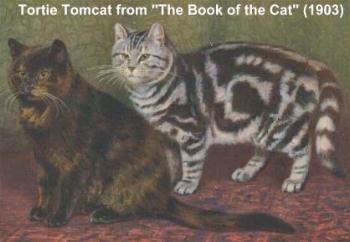
NINETEENTH, TWENTIETH AND TWENTY-FIRST CENTURY REPORTS OF TORTIE TOMCATS
According to Roy Robinson's 'Genetics for Cat Breeders' out of a total of 125 kittens produced by black female x orange male there was 1 tortoiseshell male. The majority of calico or tortoiseshell males studied in recent years were from tortoiseshell (with or without white) females and were XXY (Klinefelter) or XXXY (chimera) genetic make-up. Further studies in the early 2000s on the chromosome complement and histology (structure) of tortoiseshell males in the UK and USA indicated around 0.43% of chromosomally abnormal (XY/XY, XX/XY or XXY) tortoiseshell male cats in the UK and 0.033% in the USA.

NINETEENTH CENTURY REPORTS OF TORTIE TOMCATS
During the 1800s, cat breeders had little understanding of inheritance though some deduced that the ginger tomcat was the male equivalent of the tortoiseshell female. They didn't understand why this was so, and some breeders described theoretical breeding programmes that they believed would "fix" the tortoiseshell trait in male cats. Photos from this era are black and white or sepia and don't show the tortie males in all their glory.
There is a mention of a tortoiseshell tomcat exhibited in 1803 in an article in the Birmingham Mail, 4th May, 1907: TORTOISESHELL TOM: It may not be generally known that tortoiseshell tom cats are exceedingly valuable, and some of my readers may possibly have a small fortune within their grasp without being aware of the fact. Some years ago one was exhibited at the Crystal Palace Cat Show by quite a poor man, who had been paid by a London cook to make away with the animal. Regarding it as rather a fine cat he decided to exhibit it, and was greatly surprised when it took premier honours, and was at once snapped up at a big price. The following advertisement which appeared in the Morning Herald on April 2, 1803, shows that the tortoiseshell tom was regarded as a great curiosity in those days; The amateurs of natural history and the most eminent naturalists, runs the advertisement, have ever considered a tortoiseshell male cat as one of the rarest productions of nature. A phenomenon of this kind was lately sold for upwards of 200, and is now being exhibited in the Strand. Several persons anxious to profit by such circumstance have endeavoured to impose on the credulity of the public by offering tortoiseshell male cats for sale. We should not wonder if many adventurers may be tempted to speculate in this line, but it is necessary to repeat that such an animal is one of the most singular productions of nature, and for ages past has been sought but seldom found. It isn't possible to confirm the colour, though it is likely that the "several persons" who sought to profit from their own tortoiseshell male cats were using black dye on ginger tomcats (as happened many years later at a cat show).
The News of the World, March 16th, 1851 reported the case of a stolen tortie tom-cat in North London. Again, it isn't possible to verify the cat's colour: A TORTOISESHELL TOM CAT
- An elderly gentleman, residing in Charles-street, Islington, applied for a summons against a party, his next door neighbour, for detaining a tortoiseshell tom cat.
- Applicant said that a favourite pet tom cat had been in his family ever since its infancy, and become as if it were one of the domestic household, and was doted upon by his wife and daughters; in fact there seemed to be a feeling of reciprocity existing between them, and applicant himself must confess that he entertained a sort of paternal affection for poor grimalkin in consequence of its cleanly habits and eccentricities. Poor tom, however, he said, possessed all the propensities peculiar to his sex, and would wander away from home to pay his nocturnal visits, and many a time and oft did the air resound with the discordant squalling of tom and a number of his fraternity on the tiles of his neighbour s house in the dead of night, which gave annoyance to an elderly gentleman residing next door from applicant, who trapped tom, and had kept him ever since (three months) in a cage, and treated him with great severity. He had repeatedly applied for the restoration of the animal in vain, and it was really distressing to hear the continual howling of the cat, as if supplicating for protection and liberty.
- Applicant was told that he might have a summons if he chose, but it might be better to adopt proceedings in the County Courts.
- Applicant preferred coming to the scratch [face to face hearing] in this court, and took out the summons.
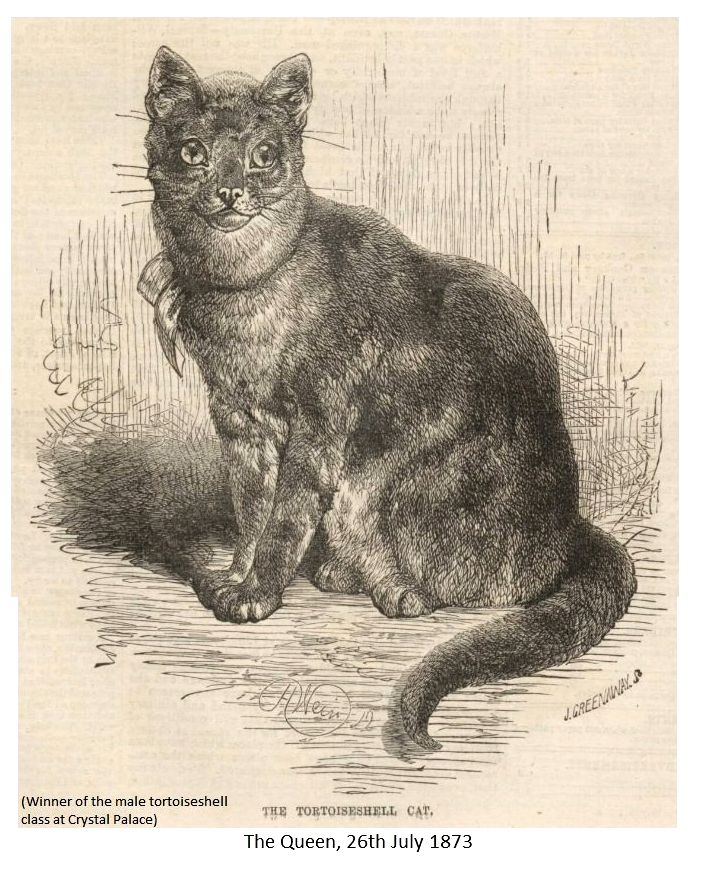
In 1872, Doctor Gordon Stables listed the classes at cat shows at the Crystal Palace and at Birmingham. Regarding the shorthairs of Class 1 he noted "First on the list comes Tortoiseshell Tom". Stables considered Tortoiseshell Tom an ugly cat and expressed surprise that he only seen one tortie tomcat, and that one died at three months old. According to Rose Tenent in her book "Pedigree Cats" (1955): "Both the Short-hair Tortoiseshell and the Tortoiseshell-and-White varieties are very handsome animals, and, like their Long-haired counterparts, most useful for breeding purposes. Both types consist almost entirely of females. In fact, the largest number of males which have ever been seen together was probably in 1871, when four were exhibited at the Crystal Palace Show. One of these was a Tortoiseshell, and the others were Tortoiseshell-and-White. During the next few years several Tortoiseshell-and-White males appeared at the various shows, including the famous prize-winning cat, Totty, which was valued at 100. Then, as now, however, most of the males were sterile." Helen Winslow wrote of the same cats in "Concerning Cats" in 1900.
A tortoiseshell-and-white tomcat was exhibited at the Crystal Palace Show of 1871 and attracted comments such as No. 3 is a sprightly tortoiseshell Tom - the unique sample of the kind - but he is rather too largely admixed with white. And The existence of a tortoiseshell tom-cat is generally regarded as mythical, and the current belief was supported by this exhibition, as the animal was conspicuous only by its absence. Even the tortoiseshell-and-white tom was but poor colour and very feminine in appearance. At the second Crystal Palace show, we have " A Tortoiseshell Tom Cat" used to be a synonyme for an impossibility, entering _ into the same category with a blue dahlia, a white elephant, and a Fenian whom money would not make a spy. But in the Show that opens to-day this proverbial impossibility is scattered to the winds by Mr L. Smith's Tortoiseshell Tom, the very first entry in the catalogue. This reprehensibly revolutionary feline is a thoroughly pure tortoiseshell, not a white hair about him, and he squats there on his cushion, imperturbably unconscious of the crash of fine old crusted convictions that the apparition of his Tortoiseshell Tomship creates. He was valued at 50 and resided at Clerkenwell. In 1872, both the tortoiseshell tom and the tortie-and-white tom were exhibited. In 1873, there was also the splendid tortoiseshell Tom belonging to Mr. Durst, of South Lambeth,who exhibited in the working-men s class which was judged by weight; this tortie tom weighed almost 17 lbs. In the 1879 show, the class for tortoise-shell or tortoise-shell-and-white he-cats had three entries and was won by Mr John Hurry s Totty.
A class for tortie/tortie-and-white toms was listed at many of the shows, but was most often marked no entries . However, in 1873 A correspondent of Land and Water says it has been stated that the only "tortoise-shell tom-cat living" will be exhibited at the Birmingham Cat Show. Mr. John Thomson Milton, of Ballgonie, in the parish of Markinch, Fifeshire, has had such a cat for many years. He is considered a rarity, and has been exhibited as an interesting specimen of the feline race to not a few naturalists. (Tortoise-Shell Tom-Cats. Birmingham Daily Post, 28th November 1873) This cat had achieved local fame, but was not exhibited either Edinburgh or Glasgow. As well as the Scottish cat, there is this Richard Rowles, Egerton Arms Hotel, Runcorn, says-" In looking over your impression of Monday, the 17th, instant, I saw an account of a cat show to be held at Birmingham, in which they state will be shown the only tortoiseshell tomcat In the world. I beg to state that I have in my possession a tortoiseshell tomcat that Is to say at least ten years old, and can be seen at any time." (Tortoiseshell Tomcat. Liverpool Mercury, 20th November 1873)
The Lyttelton Times, New Zealand, 7th July 1886 reported a tortie-and-white tomcat in 1886. This newspaper covered the Canterbury & Christchurch areas of NZ, and there were annual cat shows at Christchurch by 1886: THE CAT SHOW. A correspondent writes to say that she owns a tortoise-shell and white Tom, and asks whether cats of this description are to be met with in this city. We are not aware of any drove of tortoiseshell and white Tommies having been observed, nor did we ever see such a creature in the throng of feline fashion on the housetops by moonlight. We may add that our ancestors have left no record of having owned a tortoise-shell and white Tom cat.
Jean Bungartz mentioned tortoiseshell-and-white cats in his 1896 book "Die Hauskatze, ihre Rassen und Variet ten" (Housecats, Their Races and Varieties) in "Illustriertes Katzenbuch" (An Illustrated Book of Cats): "One generally says that this pattern occurs only with the female cat, and that three-coloured tomcats would be very rare. Since the female sex predominates in this cat, this may not be surprising, all the more so as the three-coloured variety is not strictly limited is and can appear in each litter (i.e. mixed with other colours)."
In 1897 a tortoiseshell tomcat in Matlock, Derbyshire became famous not for its colour, but for having wings (the genetic condition Feline Cutaneous Asthenia). It was described in a local newspaper as an extraordinary large tortoiseshell tom cat with fully grown pheasant s wings projecting from each side of its fourth ribs'. The story was reported in the High Peak News of Saturday 26 June 1897: Extraordinary Capture at Winster: A Tomcat With Wings. [...]Mr Roper of Winster, while on Brown Edge near that village, shot what he thought to be a fox, which had been seen in the locality some time previously, on Mr Foxlow s land. Thinking he had missed his aim, Mr Roper gave up the quest, but returning later he found he had killed the animal. It proved to be an extraordinarily large tomcat, tortoiseshell in colour with fur two and a half inches long, with the remarkable addition of fully-grown pheasant wings projecting from each side of its fourth rib."
In "Concerning Cats" (1900), Helen Winslow wrote There has been a newspaper paragraph floating about stating that a prize of several thousand dollars had been offered in England for a male tortoise-shell cat. This is probably not true, as a Mr. Smith exhibited a tortoise-shell he-cat at the Crystal Palace Show of 1871. Several tortoise-shell and white toms have been exhibited since, and one of these has taken nine first prizes at the Crystal Palace Show; but the tortoise-shell he-cat is extremely rare However, there may have been some confusion over what a tortoiseshell cat looked like as she went on to note that a real tortoiseshell "is not a striped tiger nor a tabby. It has three colors usually, black, yellow, and red or brown; but these appear in patches rather than stripes."
1850s - The Tortoise-shell Tom-Cat and Auction of a Tortie Tomcat (correspondence from "Notes & Queries" - opens in new window.)
TWENTIETH CENTURY REPORTS OF TORTIE TOMCATS
The Scotsman, 24th August 1912, mentions King Saul and Ballochmyle Samson and tells us a little about the origins of a tortoiseshell male shown at the Crystal Palace in the early 1880s: TORTOISESHELL TOM CATS. It is strange that a tortoiseshell male cat should be such a rarity. Hundreds of fanciers and others have set themselves the task of breeding such a cat on scientific lines, but Mendelism and all the other "isms" have been of no avail, and the few odd specimens that have been seen are merely freaks and have never reproduced themselves. Darwin at one time devoted attention to the subject, but in the end came to the conclusion that the orange coloured tom and the tortoiseshell queen were originally the male and female of the same variety, and until quite recently orange coloured females were also comparatively rare, although never to the same extent as the tortoiseshell males. It was said that the late Queen Victoria gave orders that a 5 bounty should be given to all breeders of a tortoiseshell male, but I cannot say if there is any truth in the statement. The late Harrison Weir instituted and carried out the first cat show, which was held in 1871 at the Crystal Palace, and since then I do not think there has been half a dozen correct tortoiseshell toms exhibited. Several that have claimed to be so were nothing more than black cats with a few discoloured hairs in them. Mrs Herring's King Saul was perhaps the most noted; he had a long and unbeaten career, although he was anything but a pleasant looking cat. He, however, never sired a young tortoise male. Lady Alexander of Ballochmyle at a later date exhibited another male of this colour in Samson. He had a much better head and markings than Saul, but also failed to leave a son of the same colour. The first tortoiseshell male shown at the Crystal Palace was in the very early eighties, and he caused quite a sensation, besides winning a lot of prize-money and plate. He was neither handsome nor attractive, and his lucky owner had been paid one shilling by an irate London cook "to remove that ugly troublesome cat from the area," where he had sought shelter. [an area was the small courtyard at basement level at the front of a Georgian terraced town-house.] He was the victim of the vicissitudes of life, as he was dragged from what he may have regarded as the happy darkness of a cellar, into the limelight of public favour. Tortoiseshell cats are not numerous in any shape or form. I knew one tortoise female that lived seven or eight years , but although she bred a large number of kittens of many colours, she had only three females during that period of the same colour as herself. All the tortoise males I have referred to have been short haired specimens; the long haired tortoiseshell tom has still to be bred.
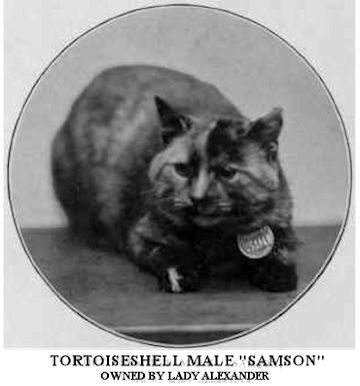
Another early report of a male tortoiseshell cats is a British Shorthair exhibited in early English cat shows (1900s). Lady Alexander's winning cats included Champion Ballochmyle Samson (left), an apparently tortoiseshell male. Frances Simpson, in "The Book of the Cat" (1903) describes the black-and-orange tortoiseshell and states "At the present time we have Lady Alexander's and Mrs Herring's males - 'Champion Samson' and 'Champion King Saul'." Elsewhere she writes "Amongst many celebrities in the feline world which have been born or bred, or have found their habitation at the Lestock cattery, I may mention "King Saul," the noted tortoiseshell tom who still holds a unique position at our shows, and won the Coronation Cup at the Botanical show." In the chapter on short-haired cats, a cat judge, Mr Jung, elaborates on these tortoiseshell toms: "One of the singularities of the breed is the nearly entire absence of males in every litter; in fact, I remember the say was that a tortoiseshell tom was as scarce as the dodo. At the present time however, we hve two good toms - viz. 'Champion Ballochmyle Samson,' winner of no fewer than twelve first prizes and championships, the property of Lady Alexander, and 'Champion King Saul,' winner of numerous championships and first prizes, owned by Mrs Herring. Both these males are very good, and whenever they have been penned together it has always been a difficult matter for me to decide the winner.
Mr Jung's account also tells us that 'Ballochmyle Samson' was a fertile tortoiseshell male: "In females, 'Ballochmyle Bountiful Bertie' (sire, 'Ballochmyle Samson') ..." and the photograph shows him to be very definitely a brindled tortoiseshell.
Elsewhere, Frances Simpson noted that tortoiseshell toms were rare, but stated "A number of clever fanciers and breeders have used their best endeavours and patiently persevered in the fruitless attempt to breed tortoiseshell male cats. In my long experience I have never known anyone who has succeeded, and those specimens that have been exhibited from time to time have been picked up quite by chance. I recollect, many years ago, at the Crystal Palace show, seeing the pen of a short-haired cat smothered with prize cards, and the owner of the puss standing proudly by, informing inquirers that it was a tortoiseshell tom that lay hidden behind his awards. This man had been paid a shilling by a London cook to take away the troublesome beast out of her area! He had taken it away to some purpose, and his surprise at finding himself and his cat famous was amusing to behold."
In 1912, a male Tortoiseshell and White was registered with the GCCF, being "Ballochmyle Bachelor", owned by Lady Alexander, bred by C Adkin, born 11th March, 1905, sire "Jabez", dam "Kit". He won 1st Prizes at the National CC Show in 1909, 1910 and 1911 and at Westminster in 1911 and 1912. There seem to have been several tortie males from the Ballochmyle line suggesting either some very interesting genetics in the Ballochmyle line.
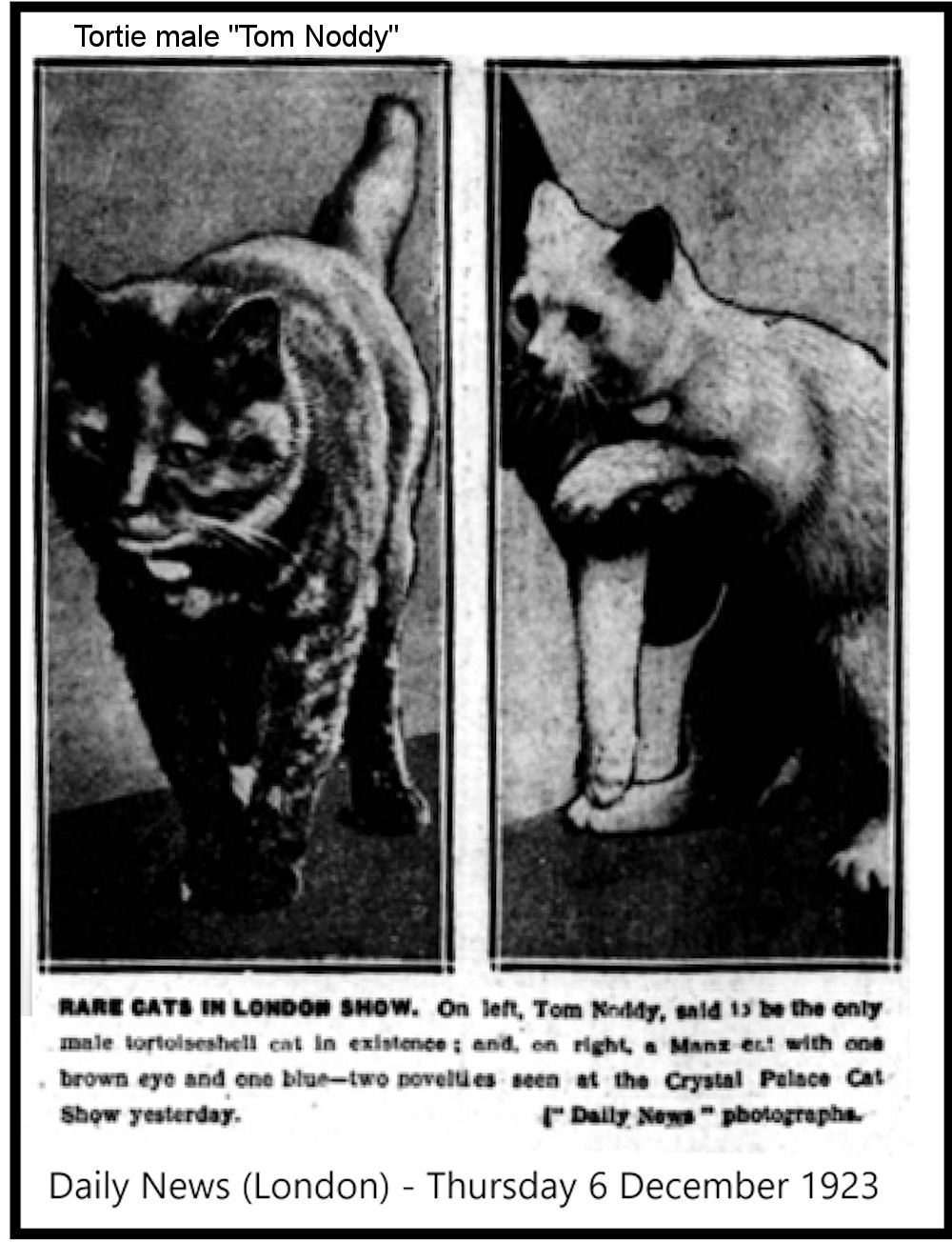
In 1927, Signor de Southoff, from Florence wrote of a local race of cats seen at Viege, above Aigle, Canton Vaud, in Switzerland. In addition to red longhairs ("Carthusian cats") tri-coloured male cats were apparently not uncommon in the village, although they were not specially bred or selected. The strain was apparently restricted to the village.
1929 brings us back to Lady Claud Alexander again and this article entitled Why so Few Tortoise-shell Males? in the Yorkshire Evening Post, 4th September 1929. Cat breeders all over England are concentrating on producing the perfect male tortoise-shell cat. While there are many tortoise-shell females, or queens as they are called, the males are extremely rare, and scientists are at a loss to understand this difficult problem of heredity. Lady Claud Alexander, and authority on cats, told a reporter to-day: If the pedigrees of all the tortoise-shell male cats in England could be traced, it would be found that they are all closely related. The real difficulty is that so many of these cats are unfertile, while in a litter of kittens the males are either red and white, or black and white, but very rarely combine the three colours in the true tortoise-shell pattern. The University of Liverpool has a male tortoise-shell cat. He has been successfully mated to black, red and tortoise-shell queens, but there is still no tortoise-shell son. This cat, whose name is Lucifer, is the special care of scientists who are trying to discover how it is that these fine cats are so scarce. During 30 years, Lady Alexander has had three tortoise-shell males and five tortoise-shell and white males, which are almost equally rare. One of these was bought in a London store for 6s., and eventually became a champion. Mrs. F. Langdale, of Hove, the former owner of Lucifer, received many offers from naturalists in Europe and America to buy him, but she declined to let the animal leave England, and so he is installed in pampered luxury as the honoured guest of Liverpool University.
Another Tortoiseshell Tom Cat (The Ottowa Journal, August 15, 1936) writes London. There are now SEVEN tortoiseshell tom cats in all England. A few days ago there were only six. Thet seventh tom is one of a family of four which arrived at Balham-hill, S.W. The mother is a prize tortoiseshell, and the father a black Persian. During the last thirty-six years only twenty-one tortoiseshell tom kittens have been born in this country, and of these eleven were the property of Sir Claud Alexander, the cat breeder, of Horsham, Sussex, who has made a special study of them. Plenty of tortoiseshell female kittens are born, but, for some strange reason, the male variety is particularly rare. Nobody can tell why. Sir Claud had contributed to scientific journals, having studied fat-tailed sheep (and their hybrids) and various breeds of cattle with a view to improving the breeds.

Among pedigree cats, a famous tortoiseshell male was Poldhu in the 1950s. Poldhu was sired by founding Cornish Rex stud Kallibunker. Poldhu was a blue-cream-and-white male who sired a number of kittens. He was later owned by the noted cat breeder Brian Sterling-Webb and had been examined by several geneticists who attested to the fact that he was a blue-cream. Because Poldhu was both tortoiseshell (blue-cream) and fertile, veterinarian Dr A G Searle took a tissue biopsy for research. This had the unfortunate side-effected of rendering Poldhu sterile. To add insult to injury, not only was Poldhu rendered sterile, the tissue sample was lost. Some contest that Poldhu was actually blue-tabby-and-white (which contradicts the veterinarian's interest in getting a tissue sample). According to "The Rex Cat" by Phyllis Lauder, Poldhu sired red and cream females out of four different queens. He could only do this if his X chromosome carried the gene for red (diluted to cream by other genes). His owner, Mrs Ennismore, recorded that Poldhu sired red or cream females, but records apparently show that he sired blue tabbies out of a solid blue female. It seems possible that Poldhu was an XY/XY Chimera.
Poldhu was not the only male tortie Rex. Mrs Roma Lund of Maidenhead owned a blue tortoiseshell Devon Rex called Ben. Though there were no details on his fertility, Ben was valued at 1,000 for his rarity. The account was undated, but appears to be 1970s when Devon Rexes were rare and expensive, whatever their colour.
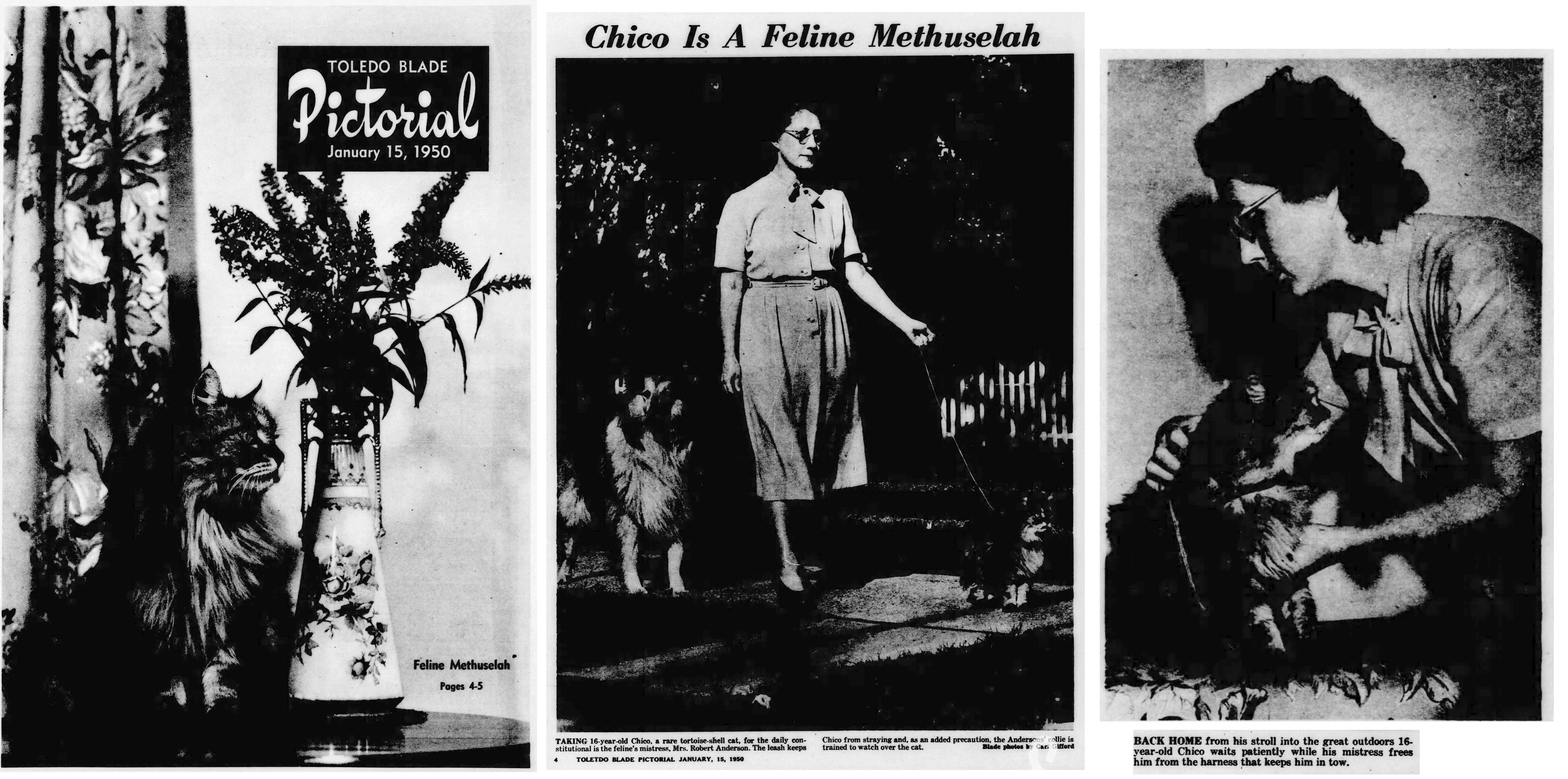
A longhaired tortie male was mentioned in The Blade (Pictorial section), Toledo, Ohio, 15th January 1950 in an article entitled "Rare Tortoise-Shell Male, Pet of Toledo Family, Attains Incredible Age of 16." The article is full of inaccurate information and the available copy is barely legible. He is described as red, brown and white - possible tabby-tortie. "The Spanish Tortoise-shell tom is the rarest cat in the world. Completely sterile, about one is born to every 100,000 females – and only because the female has mated with a red-cream or black Persian male. The great P.T. Barnum offered an award of $1,000 to any person who could produce a pure tri-coloured male. Nobody claimed the money in his lifetime. Some years ago Life magazine, while discussing cats, said that 'there is no male tortoise-shell in America.' Since then, two have turned up: One in Babylon, N.Y., owned by Mrs. Gleis, is still practically a kitten at 14 months; the other, here in Toledo, is a battle-scarred veteran of 16 years. Owned by Robert and Sarah Margaret Anderson, 2808 Berdan Ave. [. . .] red, white and brown." The available photos were black and white.
Another tortie male was mentioned in The Daily Report, Ontario, California, 3rd December, 1953: "West Shore Cat Show Draws Over 400 Entries [. . .] One of the very rarest cats in existence, a male tortoise-shell, is being entered by Mrs. Deedie M. Sallee, North Central avenue, Chino. Mrs. Sween [organiser] said that male cats just don't come that color, and this is only the second one in the country that she knows about."
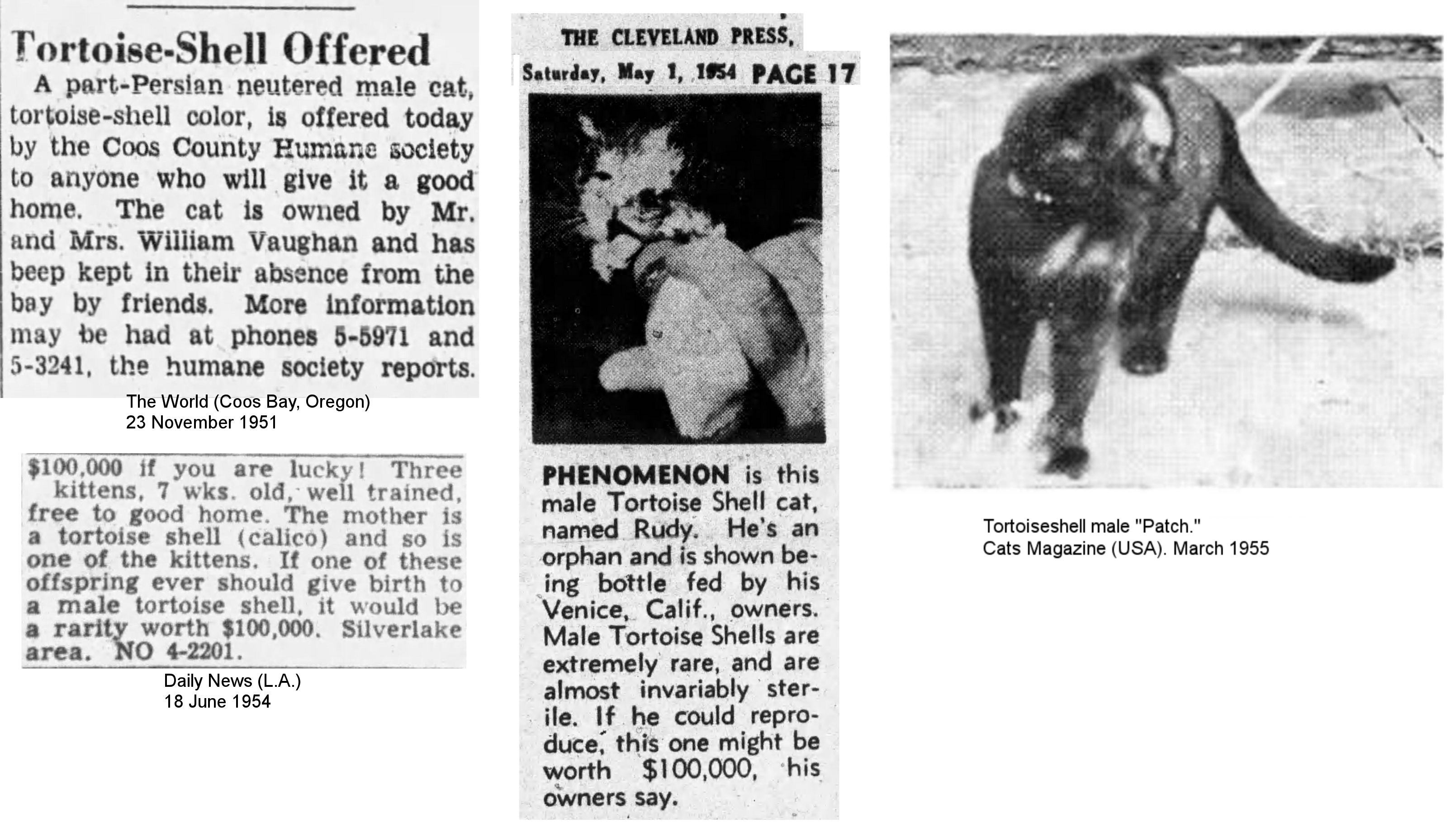
The front cover of the February 1955 issue of the American "Cats Magazine" was wholly devoted to a picture of Double Champion "Torti Man of Gallus", a fertile tortie male with rather battle-scarred ears. he belonged to Mr Russell Middleton of Dallas, Texas. Torti Man had sired several litters, but an analysis of the data suggests the females had asp mated wth other males! And in March 1955, Our Cats printed a photo of a tortie male called "Patch" who belonged to Mrs Cotterell. Patch had mated a tortie female who produced three kittens - one like its mother, one something like its mother and a black with a ginger tint (rusting). That meant Patch was breeding as a self black
In the 1960s or 1970s a Van-patterned male longhair turned up in the USA. This cat had a blue spot on his head mingled with cream, a cream spot on his body and a blue tail. Blood and skin samples were sent to Pennsylvania University for chromosomal investigation. The University concluded that the tortoiseshell Van male would be fertile, which meant the blood and skin cells contained the normal XY complement. His sister was black, indicating a black father and tortie mother.
There has also been a fertile tortoiseshell-point Siamese male in England who has sired a number of litters before being neutered. Marilane Harlequin or "Hal" (1980 - 1994) bred as if a seal point i.e. passed on the gene for black. In his show career he was a Champion and a Premier (equivalent of a neutered Champion) although there is no show class for tortie males. He was bred from a tortie-point female and a cream-point male.
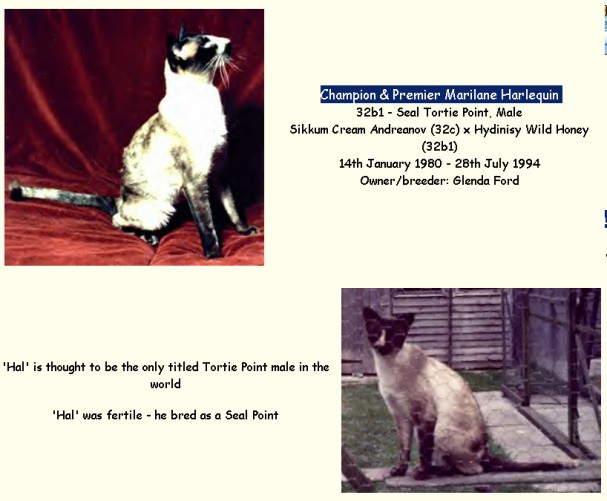
In the 1980s there was a Dutch-bred dilute calico (blue-cream-and-white) British shorthair male called Benjamin's Jos Brink. This cat sired litters between 1982 - 1987.
In 1988, solid red Maine Coon male Simba joined Oetisheim Maine Coon Cattery and was mated to two females, but failed to impregnate either of them. When mated to a different stud, the females conceived. So Simba was mated to a proven fertile female, but again failed to impregnate her. He was 3 years old and should have been sexually mature by then, so the owner sent off a blood sample for testing. The result was that Simba was found to be a mosaic, having some normal cells with 38 chromosomes (38XY) and some abnormal cells with the XXY chromosome set (39XXY) i.e. he was an XY/XXY mosaic. On closer examination, Simba was found to have a small black marking on his left ear and a sprinkling of black hairs across his body. This was believed to be lentigo which is not uncommon in red cats and is a bit like dark moles in humans. He was exhibited until 1991 and none of the judges had marked him down because of the black spot. Being infertile, but still exhibiting male behaviour, Simba was neutered in 1992. Possibly he had developed from an XXY embryo, but most of his cells lost the X chromosome that carried the normal (black) colour so he appeared to be a solid red male with harmless black freckles. However the cells that formed his testes were still XXY which meant he was sterile.
One of the most interesting cases surely has to be the "Tripple" line of Norwegian Forest Cats. This line apparently produces fertile male calicos at least every third generation. The foundation male of this line was a fertile calico male called Tripple. Tripple had a black patch on his flank which may be a somatic mutation, but otherwise appears to be a red/white bicolour. Some of these calico toms could be seen at Dutch cat shows. They look like ordinary red or red bicolour males, but have small black spots - these spots are very definitely black, not merely dark red. Some also had a mix of red and black in their coat, with the red always predominating. Studies of pedigrees from Tripple's breeding line indicated that calico males occurred every third generation and sometimes as often as every second generation. There was apparently a distinct ratio of calico males which certainly merits a more detailed study of the phenomenon. Initial studies, based on phenotype rather than genotype, showed no evidence of XXY (Klinefelter) in the line.
Snowknight Siberians bred by Caroline Sharp have also produced 3 generations of tortoiseshell tabby males. There are a few other cases now documented of multiple generations of tortie males. Nicoletta Locati breeds Persians and her fertile tortie male produced a daughter who produced a blue tortie (blue-cream) male in 2008. In addition, another kitten (sold in December 2007) turned out to be a blue tortie male when judged at a cat show. Sphynx breeder Sandi Keeler also had a second generation tortie male; both father and son are fertile.
A fairly casual surf of the internet and usenet (newsgroups) turns up a number of cases of tortoiseshell male pet cats, some identified as XXY make-up, including adverts offering rare male calicos for sale. Some reports must be taken with a large pinch of salt. For example a supposedly calico male called Bentley was described in 1992. The owner had no idea that Bentley was unusual until someone described Bentley as a "she" and then said that cats with tricolour noses were always female. Bentley's nose was white, black and beige. The fur on Bentley's side was a mix of black tipped with beige and solid beige. However, Bentley's owner added "the beige forms circles like bulls eyes on his sides" meaning that Bentley was not a genetic anomaly at all, but an ordinary classic tabby cat with an ordinary mix of agouti and non-agouti fur! One wonders how many "tortie toms" are nothing of the sort, except in their owner's imagination or because the owner is unfamiliar with the tabby pattern?
In 1992, Mindy Machanic reported a 12 week old male calico called Huggy Bear. The vet was initially dubious that the cat was male. Huggy Bear was white and black and red with a Van pattern: white body with one large black spot striped with light tan, white legs with a tiny black spot, a fluffy black tail, striped with light tan and a white head with black and red/reddish brown triangular patches in front of his ears. He was healthy and not at all retarded as initially feared; he was also developing some typically male behavioural traits. In 1994, Paul Atchley bred a litter of calico kittens including two male calicos which were mostly white with orange, black, and grey patches. Several other tortie males were mentioned in 1994, including one called Smudge that went missing for six weeks before being found in a ventilation pipe and a a 7 year old tortoiseshell male barn cat called Injun.
In 1996, a newsgroup posting referred to a calico male called Camille who was, quite reasonably, assumed to be a female when adopted as a kitten. Camille has wide hips, walks with a wide gait, is healthy and has a sweet temperament; traits suggestive of XXY chromosomes (Klinefelter). He sounds similar to Brody Baker featured on the page about XXY males. In 1999 another writer said that her mother had bred numerous tortoiseshells including 2 male torties, but to her disappointment both males were sterile.
In 1997, Maine Coon Stormwatch Maxwell was the single kitten born to silver torbie female Cyclone and black smoke male Tatsumaki. Only one kitten was born; it appeared to be a red silver tabby, but had a back patch on the nose and under one eye. In this case, the most likely explanation is a somatic mutation, like a port wine stain in humans.
TWENTY-FIRST CENTURY REPORTS OF TORTIE TOMCATS
In November 2022 Kenny, in France, sent me photos and information about his 8-month old LOOF-registered black silver tortie-and-white male (neutered) Maine Coon tortie with white. Yamato (registration name Casanova Silent Wave). He was bred in Ukraine and is now living in France; his mother is red silver, his sire is black silver and he has a tortie sister. He has a nearly solid black paw that contrasts with his other paws, which are white/cream coloured. DNA analysis of Yamato by Marie Abitbol showed he is a chimera, with sometimes even 4 alleles (in FCA149 in particular). The Antagene lab said there were indications of two fathers in his DNA. It turns out that the mother had mated with two males Maine Coon, and Yamato got the genetic blueprint of both fathers. They didn't elaborate on whether he is a chimera XX/XY or a chimera XY/XY, or even XY/XXY.
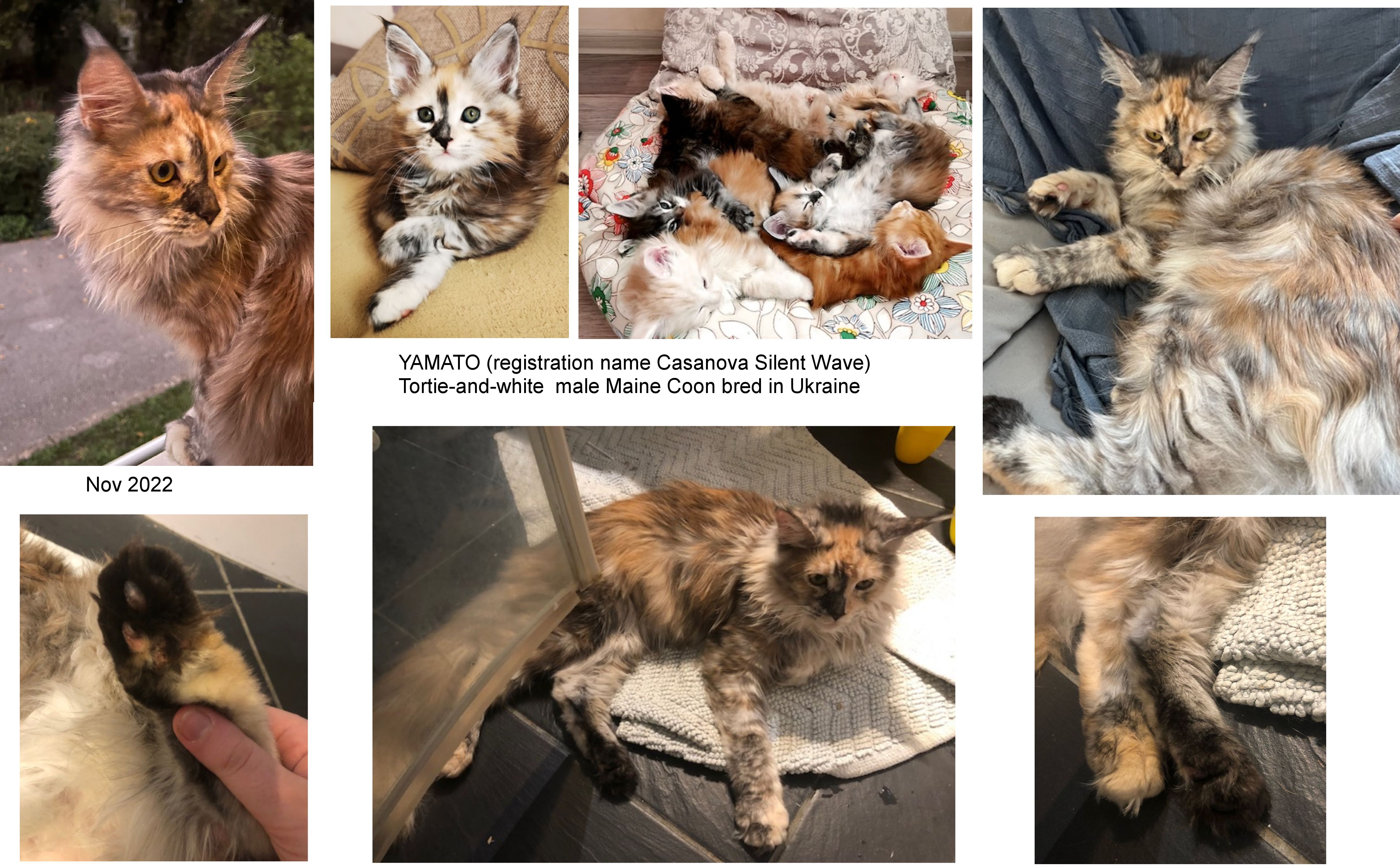
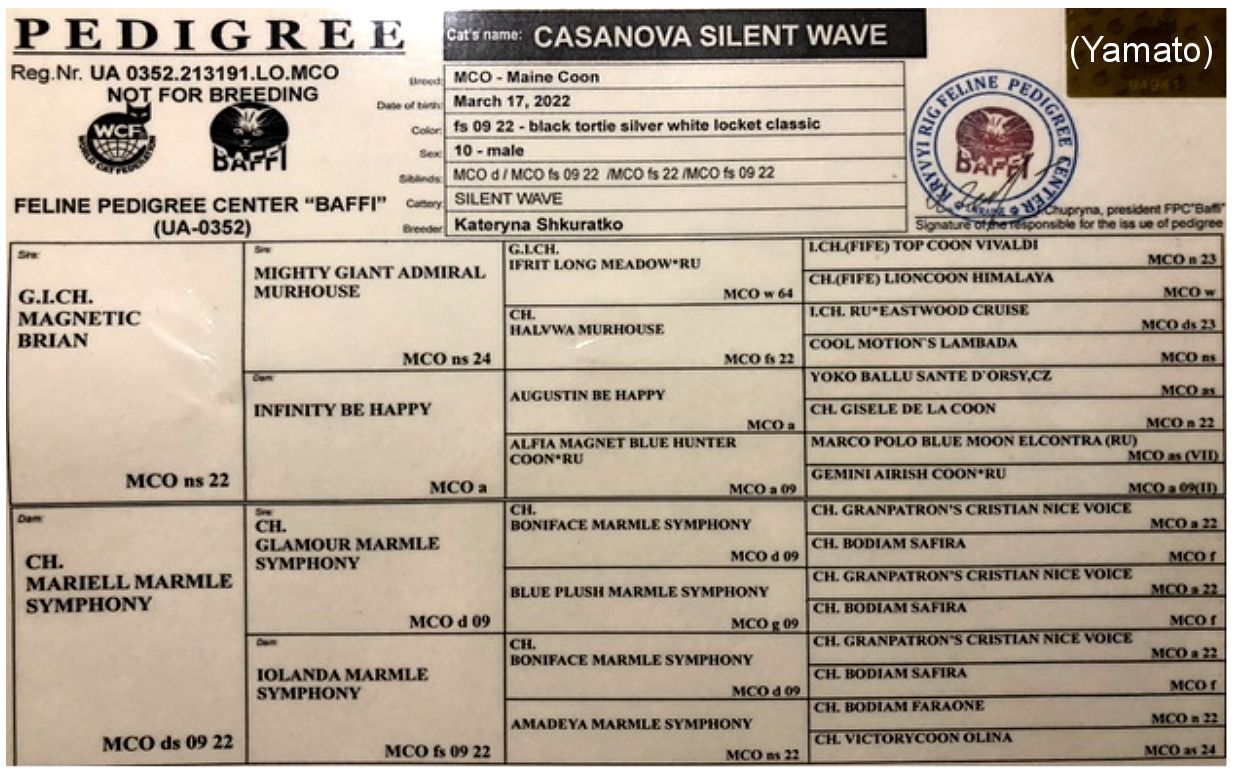

These photos of a tabby-tortie tomcat are from Fabiola Wesdijk in 2018. Because he has only this one patch of black-pigmented fur, this may be a somatic mutation where eumelanin is being produced in place of phaeomelanin. Somatic mutations are like birthmarks in humans.
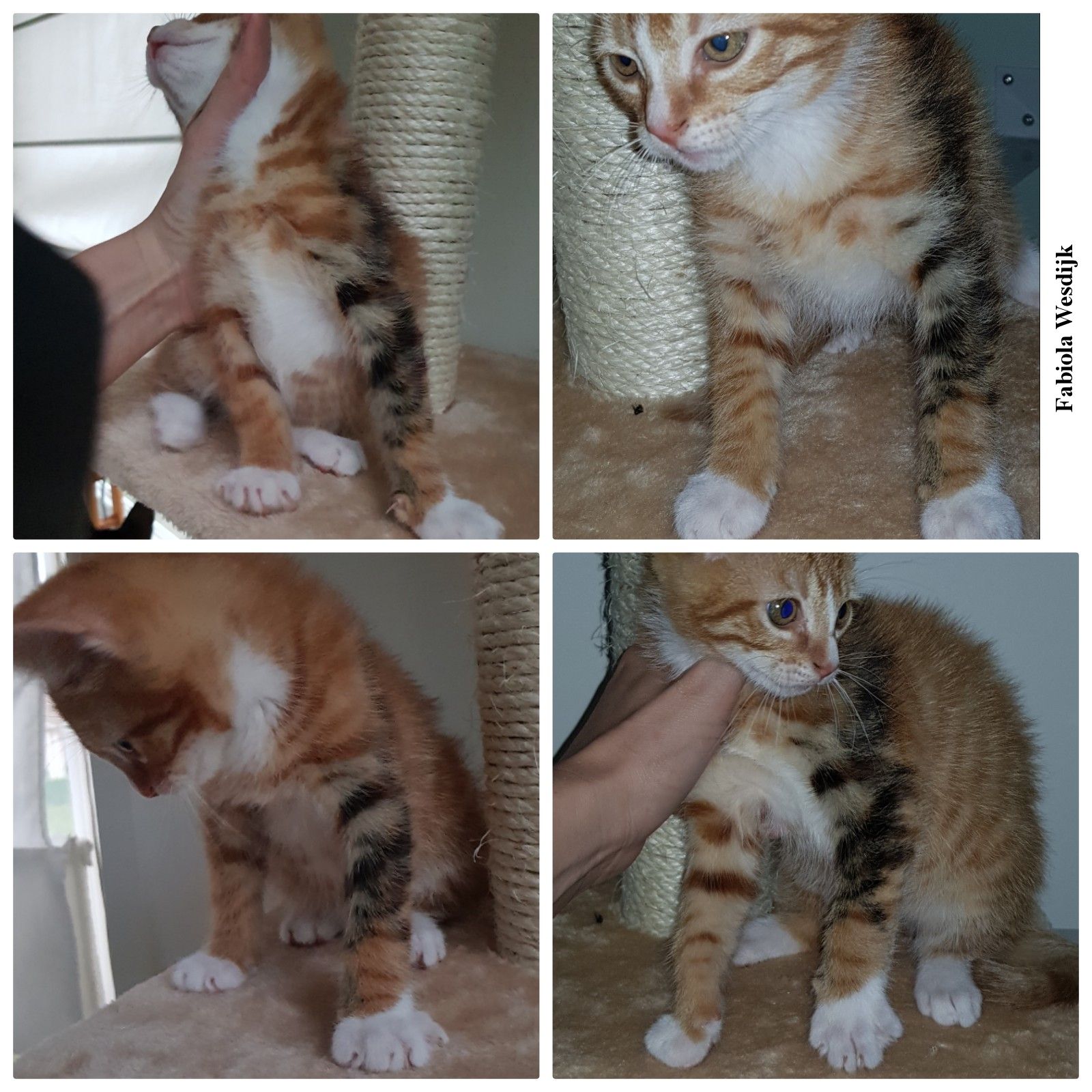
In 2001, a very macho-acting dilute tortoiseshell male, Toby, was reported on Usenet - his fertility was unknown, but even after neutering he tried to mate with other cats. In 2001, a large, sweet-natured dilute calico (blue/cream tabby & white) male called Calvin was reported. The owner was tempted to breed him due to his rarity. In 2002 a family of four stray cats were reported including a red longhair, a black shorthair, a tortie female and tortie (predominantly red) male - this covered most of the normal colour possibilities for the "O" gene plus the anomalous colour!
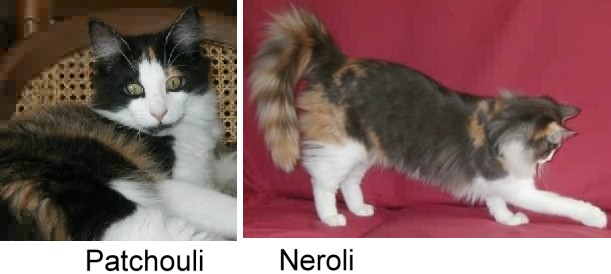
In 2001, a litter of French-bred Norwegian Forest Cats (Abelia Cattery) contained not one, but two, tortie-and-white tomcats. The litter comprised a black smoke boy, a cream-and-white boy, a blue tortie-and-white male (Neroli), and a tortie-and-white male (Patchouli). Both males proved to be fertile. Santal's Neroli has sired blue kittens, so her breeds as a blue-and-white bicolour. Patchouli has sired both tortie and blue tortie so he breeds as a red-and-white bicolour carrying cream (dilution factor). Having two tortie males in a single litter is intriguing - perhaps a red male fertilised egg and a black male fertilised egg collided , but instead of fusing they exchanged some cells. Or perhaps they fused, but later separated again in the way that twins form.
In 2003, another Usenet posting reported an orange tabby female called Carrot who produced a male calico kitten in her first litter. Other reports sound like cases of mistaken identity e.g. on Sept 20th 2002, a shorthair tortoiseshell male cat coloured grey, black and white was impounded in Bismarck, ND, USA (though this could be a silver classic tabby and white).
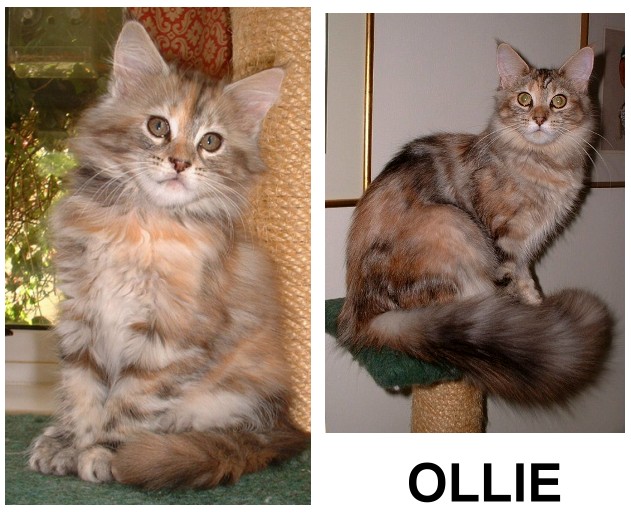
Celticoon Oleander (Ollie) is a male silver tortie Maine Coon. He can't be shown under the GCCF rules because thee is no class for male tortoiseshell cats, but he was due to be exhibited in 2006. His mother was a tortoiseshell and Ollie is believed to be a chimera.
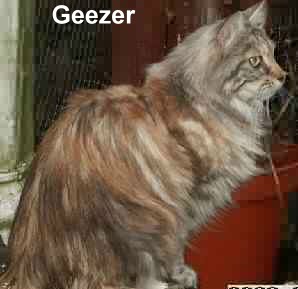
Maine Coon Koonikki Feirfiz Geezabird is an attractive torbie male that isn't quite sure of his gender identity. His mother was a black/brown tabby so the red colour came from the father, Vespa, either in the form of an additional X chromosome (Klinefelter) or fusion of a black tabby male embryo with a tortie female embryo. At 4 months old Geezer was found to have testicular tissue in place of an ovary position, then at 10 months old, a testicle dropped in the right place making him a monorchid. The vet believed him to be a sterile XXY male. Geezer has both male and female behaviour - he has maternal instincts, he sometimes calls like a female to be mated, and at other times he tries unsuccessfully to mate with a female. Geezer's sire Vespa sired a second tortie-tabby male in a mating with a brown tabby female. This second tortie male was very brightly coloured and not identified as a male tortie until 9 weeks old. Perhaps some lines of Maine Coon are prone to producing chimeras or masculinised females, or perhaps Vespa was producing XY sperm.
In June 2010, "Right" - a male tortoiseshell-tabby (torbie) arrived at the Atlanta Humane Society in the USA. Right was automatically sent for spaying on the assumption the tortie colouring meant the kitten was female. When the vet shave Right, she discovered the kitten to be male, the first one she'd seen in 8 years of working for the shelter. Although the the website veterinarypartner.com said tortie males are due having XXY genetic makeup, without karyotyping Right, it's not known whether he is XXY (and sterile) or has the more common condition called chimerism (and fertile). Many websites still carry the out-of-date information that assumes XXY to be the sole (or most common) cause of male tortie cats.
Tortoiseshell males from pedigree breeds are perhaps the most interesting as these have complete genetic histories detailing the colours of parents and related cats. Riëtte van Beek has collected information on a number of tortoiseshell male cats, their parentage and their offspring (if they are fertile). In addition to the cases detailed above, these enigmas include Kapamba's Home Miracle (tortie-and-white Norwegian Forest Cat, fertility and genetic make-up unknown) and Dar es Salaam's Varsha (male Seal-Tortoiseshell Point Birman who passes on red).
I find it interesting that so many of the recently reported tortie males belong to longhaired breeds such as Maine Coons (the most reports so far), Siberians (multiple generations), Norwegian Forest Cats, Birmans and Persians.
EARLY STUDIES OF TORTIE AND CALICO TOMS
One of the first discussions of tortoiseshell inheritance, including tortie tomcats, was by L Doncaster in 1905 and is mentioned in Experimental Zoology (Publ. Macmillan & Co, London, 1910) by Thomas Hunt Morgan (Professor of Experimental Zoology, Columbia University). Although this discusses tortie in general, it is reproduced in full as it draws conclusions about tortie toms. Dominant and recessive traits were understood, but sex-linked traits were not (my comments are marked "note").
Doncaster [Doncaster, L. On the Inheritance of Tortoiseshell and Related
Colours in Cats. Proc. Cambridge Phil. Soc. XIII. 1905] has brought
together a number of records, obtained from owners of pedigree cats,
that show the color inheritance of certain breeds. He examined more
especially the question as to why tortoiseshell cats are nearly always
females. His conclusions, as will be seen, have an important bearing on
the problem of dominance in relation to sex. Tortoiseshell kittens may
be obtained in any of the following matings : -
(a) Tortoiseshell F by tortoiseshell M
(b) Tortoiseshell F by black or blue M
(c) Tortoiseshell F by orange M
(d) Orange F by orange M [note - this is erroneous!]
(e) Orange F by black or blue M
(f) Black or blue F by orange M
In all of these matings, in addition to tortoiseshell, kittens of other
colors may appear, viz. :-
(a) Tortoiseshell F by tortoiseshell M gives tort, orange, black.
(b) Tortoiseshell F by black or blue M gives tort. F, orange M , black M & F .
(c) Tortoiseshell F by orange M gives tort., orange, black.
(d) Orange F by orange M gives either tort., orange (or blue) or only orange. [note - this is erroneous!]
(e) Orange F by black M gives tort. F, , orange M .
(f) Black F by orange M gives tort., black (and probably orange).
(g) Black F by black M gives only black (or blue).
From these results it appears that tortoiseshell is a heterozygous color produced by the meeting of orange and black gametes. The explanation that tortoiseshell cats are nearly always females and rarely males is owing to orange nearly always dominating in the male over black, while in the female the dominance of the orange is incomplete, so that tortoiseshell results. In other words, in the female sex the orange and the black both exist together, while in the male sex the yellow usually dominates. A few examples will make the conclusion clearer. For instance, in mating (e) when an orange female is crossed with a black male, only tortoiseshell and orange kittens are produced; if both the orange and the black breeds are "pure," the female offspring are tortoiseshell and the males yellow. In the reverse mating (f), where a black female is crossed with a male orange, the male may be heterozygous (i.e. having both black and orange germ-cells [note: this was erroneous]), hence black kittens may also be produced. The kittens will be black males or females, tortoiseshell females, and orange males.
When a tortoiseshell female is mated with a black male, the male offspring will be orange, because the tortoiseshell is heterozygous. It is also evident why orange females are very rare, although orange males are common, since in all matings in which one of the parents is black, orange can appear only in the male offspring. "If, therefore, the great majority of orange males contain recessive black, when they are paired with tortoiseshells, only a quarter of the kittens will be pure orange, and only half of these females." [note: an incorrect conclusion; sex-linked traits were not understood in 1905]
The preceding statements show the relation of the colors orange and black. The inheritance of two other colors was also examined ; namely, cream and blue. Cream appears to be a dilute form of orange, and blue of black. The blues breed true (when derived from yellow ancestors) and are therefore recessives or homozygous. A cream female and a blue male give blue tortoiseshell (blue and cream), cream males, but no blues, since the cream dominates incompletely in the female, completely in the males. On the other hand, a blue female and a cream male give blue tortoiseshell females, blues of both sexes, and possibly cream males. These and other results show that the dilute forms behave in the same way as do the stronger colors. Thus cream is dominant over blue in the male, but when blue and cream meet in the female a tortoiseshell results.
It has been stated that male tortoiseshell cats are known, although they are rare. It must be assumed that in such cases the dominance of the yellow is incomplete as in the female. This means that while complete dominance is usually associated with the male character, it is not necessarily always associated with this sex. It is interesting: to find that when a male tortoiseshell is mated with a female of the same color, the kittens are tortoiseshell, orange, and black. This is what is expected on the assumption that the germ-cells of the tortoiseshell are black and orange (with the alternate character latent on my view). The prepotency of different tortoiseshell individuals (males) seems, however, to vary. [note: this would be because the fertile tortie males were chimeras]
It should also be pointed out that the colors described above may be associated with a certain amount of white which reappears in the offspring without, however, affecting the inheritance of the other colors. The piebald character stands as a unit contrasted with uniform coat, but is independent of any particular color.
 |
|
One of the first scientific studies was that of the fertile blue-cream male Cornish Rex Poldhu in the 1950s. Veterinarian and researcher Dr A G Searle took a tissue biopsy for research, but this had the unfortunate side-effected of rendering Poldhu sterile. Worse, the tissue sample was lost. Mating records indicate that Poldhu sired red and cream females out of four different queens and blue tabbies out of a solid blue female.
There is a report about a tortoiseshell tomcat in the Canadian newspaper The Lethbridge Herald (16th October 1951) regarding The Missing Rare Cat. The cat in question was on loan to Professor Haldane for breeding experiments, but went missing when boarded at a dishonest veterinarian s clinic: Male tortoiseshell cats are so rare that when Miss D. M. White, a Welsh lady, reported she had one, Professor J. B. S. Haldane of London University, was so interested that he begged the loan of him for a breeding experiment. One year later Tommy became the father of a litter of kittens by a black mother. That was a year ago, and Tommy remained in the professor's home where there were six other cats. One of them became ill, and for safety's sake Tommy was sent to a veterinary surgeon's cattery. All trace of him has been lost. The vet happens to be in a penitentiary for five years on a larceny conviction, and is unable to give any information. Professor Haldane and his secretary have made many enquiries without success. The governing council of the Cat Fancy with which the cat was registered, and the Cats' Protection League have made continuous1 investigation, and hundreds of letters and phone calls have been received, but none of the clues have produced Tommy Tortoiseshell, Miss White is justifiably vexed about it.
In his book "Cat Genetics" (1955) Albert C Jude discussed the anomaly of tortoiseshell mails and included a photograph of a fertile brindled tortoiseshell tomcat. He noted that tortie males occurred only as rare exceptions and were almost always sterile. At the time, the genetic constitution of the tortoiseshell male was unclear; one explanation was that a tortoiseshell male was in fact a genetically-determined (XX) female which, under the influence of male sex hormone from another embryo of the same litter, developed as a sterile intersex animal like the freemartin seen of cattle (discussed later in this article). He added that where the male sex hormone had been unusually concentrated, a fertile XX tomcat might result. Cutler and Doncaster (1915) had found that sterile tortie males entirely lacked normal reproductive cells.
During investigations carried out by Jude himself during 1966 in connection with a new theory put forward by Professor Komai of Japan, six tortoiseshell-and-white tomcats were reported in Great Britain. Professor Komai s theory proposed that the mothers of all these males were themselves tortoiseshell or tortoiseshell-and-white. Only one of the reported cats, Mrs Cotterell's fertile male, had been traced and Jude appealed to readers for more instances - with full data - of fertile tortie or tortie-and-white male cats. The tortoiseshell-and-white male belonging to Mrs Cotterell of Luton was described as having "a large patch on forehead and over eye of ginger and white. It has white under throat and belly. It has golden necklace, and from then on to the tail, the coat is broken with gold color on base black." That particular tortie male sired kittens on a tortoiseshell female also belonging to Mrs Cotterell. The kittens were described as "one very like the mother, one something like the mother, only darker, and a third, black with a ginger tint." Unfortunately, the "black with a ginger tint" kitten died before 4 weeks of age. It was thought to have been a male while the other 2 kittens were females. It was hoped to obtain test matings if the sire remained unsold.
In 1967, Cats Magazine reported on a show of five male calico cats at the previous October's Totem Cat Club Show, Wacoma, Washington. Four were displayed by arrangement of the Research Department of Rainier School, a Washington State Institution for the mentally retarded (a term politically correct at the time). One was owned by Mrs Mahaffie and had won ribbons in the previous year's show. A second belonged to Mr and Mrs RG Parrett of Bellevue, Washington. The third belonged to Mr and Mrs B Moon of Vashon, Washington. The fourth was owned by the Research Department of Rainier School, and had been given to them by Mrs Waddell of McGehee, Arkansas. The fifth was a kitten owned by Miss Erickson, of Tacoma.
For the previous 8 years, Dr Horace Thuline and his staff at the Research Dept of Rainier School had conducted a research project into chromosomal abnormalities. The main interest was Down's Syndrome in children, but male calico cats were of interest because their colouration was due to a chromosome abnormality. The report noted "It is the fortunate circumstance of black and orange being sex-linked in a cat that allows males with two x-chromosomes (a male should have only one x-chromosome) to be identified by sight rather than with expensive laboratory procedures. The rarity of Calico or Tortoiseshell male cats is evident from the fact that, in seven years of looking for them, assisted by many people all over the United States, only eleven had become available for studies at Rainier - including the five at the show."
The display included posters showing chromosome patterns for each of the cats, though amidst so many different breeds and colours of cat their unusual nature was easily overlooked by show visitors. It was not obvious to the casual passer-by that "these normal-appearing males are rarely born, and rarely survive. Because of the general casual attitude concerning pet cat litters, it is impossible to give an accurate estimate of how frequently Calico or Tortoiseshell males are born." Miss Erickson and Mrs Mahaffie were present at the display while scientific explanations about the cats, about "Project Calico" and its importance to the Rainier School studies were available from Dr Thuline and his associate Dr Darwin E Norby. The Totem Cat Club planned to donate space again in 1968 to Rainier School for "Project Calico" and with more advance planning, hoped for a better display set apart from other feline exhibits and with colour posters.
Unfortunately for "Project Calico" and its applicability to human chromosomal abnormalities, modern research indicates that tortoiseshell and calico tomcats are more often due to chimerism than to the XXY chromosome abnormality. This also means that most tortie/calico males are fertile. Dr Thuline and his associates would not have been aware of the chimera condition in 1967.
READ THE ARTICLE: FIVE IMPOSSIBLES
NEXT PAGE: Chimeras (Fused Embryos)
REFERENCES AND FURTHER READING